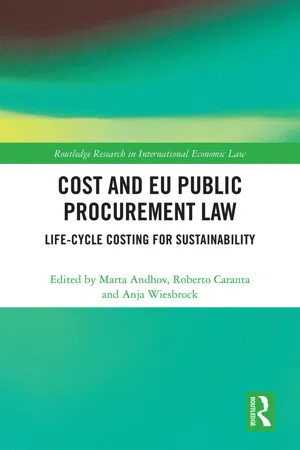
Cost and EU Public Procurement Law
Life-Cycle Costing for Sustainability
- 186 pages
- English
- ePUB (mobile friendly)
- Available on iOS & Android
Cost and EU Public Procurement Law
Life-Cycle Costing for Sustainability
About This Book
Public institutions, companies and governments in the EU and around the world
are increasingly engaging in sustainable public procurement – a broad concept
that must consider the three pillars of economic equality, social welfare and public
health and environmental responsibility when designing public tenders and
finalizing government contracts.
This book contributes to the development of life-cycle criteria tools and methodologies
for public procurement in the EU. It collects both sector-crossing contributions
analysing the most relevant theoretical and legal aspects, including
both EU law and contract theory, and sector-specific contributions relating to
some of the most important sustainable goods and services markets. The book
starts with a chapter that discusses the different approaches to including sustainability
considerations in buying decisions by both private and public purchasers,
and then goes on to examine the EU law on LCC and how it is implemented
in different Member States. These chapters address the challenges in balancing
economic and sustainability objectives under EU internal market law. One
chapter develops the analysis with specific reference to public-private partnership.
Another chapter elaborates how multi-stakeholders' cooperation is necessary to
develop LCC, based on a case study of a lighting services procurement. Three
sector-specific studies relating to social housing, textile and clothing and IT close
the book.
With contributors from a range of backgrounds including law, business, management,
engineering and policy development, this interdisciplinary book provides
the first comprehensive study on LCC within the framework of EU public
procurement law.
Frequently asked questions
Part I
Balancing economic and sustainability objectives under EU internal market law
1 What is life-cycle costing?
1.1 Introduction
1.2 Life-cycle assessment
Table of contents
- Cover
- Half Title
- Series Page
- Title Page
- Copyright Page
- Table of Contents
- List of contributors
- List of abbreviations
- Foreword
- Part I Balancing economic and sustainability objectives under EU internal market law
- Part II Sector-specific studies: experiences, shortcomings and the lessons learnt
- Index